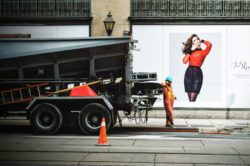
Free Flagging Training
Did you know that here at Diversified we offer FREE Flagging Training! Call your local office today to register for the next upcoming course!

Practical Safety Guide for Flaggers
FLAGGER SAFETY
Orange cones, barricades and illuminated arrow boards. These are things you’d likely see on a part of the road whenever certain operations are being done near vehicle traffic. In most cases, too, you’d see one or two people in flashy vests monitoring the traffic flow. These people are called flaggers.
Flaggers make sure that vehicles and pedestrians can move safely and quickly through or around temporary traffic control zones. They also have another responsibility. That is, to keep workers and on-site equipment safe during operations. Flaggers and traffic control devices be provided when signs, signals and barricades are not enough to protect workers, equipment, pedestrians and vehicles.
While having flaggers is proven to be effective in preventing accidents, they are actually the ones exposed most to hazards on the road. Because of this, certain precautions must be followed by flaggers:
GENERAL REQUIREMENTS
With the hazards that come with the task of flagging, flaggers must take note of the following requirements:
- Training – Flaggers must be trained in safe traffic control practices to be able to ensure the safety of everyone, including themselves.
- Good physical condition – Flagging is physically taxing work that may last for many hours. For this reason, flaggers must be physically fit. They must particularly have good vision and hearing.
- Alertness – Danger is always around the corner so flaggers must always be mentally alert. This is especially true at night when pedestrians and vehicles might miss spotting signs, signals and other important traffic control devices.
- Flaggers must also be ready to respond to emergencies that may happen any second.
- High-visibility Clothing – Flaggers must wear high-visibility clothing so that pedestrians and vehicles can see them easily even from a far distance. During daytime, the flagger’s vest, jacket or shirt should be orange, yellow, yellow-green or a fluorescent version of these colors.
For nighttime work, these similar outer garments must be retroreflective and colored orange, white, yellow, yellow-green, silver, or, again, a fluorescent version of these colors. Clothing at nighttime must also be visible at a minimum distance of 1,000 ft.
FLAGGER STATIONS
The location of the flagger station must be far enough ahead of the work zone. This way, approaching vehicles have sufficient time to stop before entering the work zone. When setting this distance, variables like pavement type & conditions, approach speed, friction factors, and tire capabilities should be considered. It’s best that the flagger has an escape route that they can use in case a vehicle breaks traffic rules.
The flagger should either stand in the barricaded lane or on the shoulder adjacent to the traffic being controlled. A “spot” construction is an exception; and in this case the flagger must take the space on the shoulder opposite the barricaded section.
The flagger station must never be in the path of oncoming traffic. Flaggers may only move into the lane after the traffic has stopped and only when they need to be visible to other traffic or when they have to communicate with a driver.
HAND-SIGNALING DEVICES AND FLAGS
Flaggers are required to use devices that help them make hand signals to vehicles. These devices are STOP/SLOW paddles, red flags, and lights. Among these devices, the STOP/SLOW paddles should be the primary and preferred hand-signaling device. Flags should only be used during emergency situations.